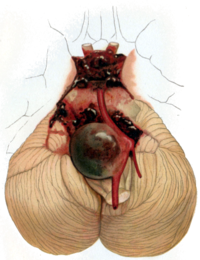
Photo from wikipedia
Endovascular therapy is the preferred treatment approach for managing ruptured intracranial aneurysms after studies demonstrated an overall safer profile than surgical clipping. 1 Evolving and refining technology also settled neuro-intervention… Click to show full abstract
Endovascular therapy is the preferred treatment approach for managing ruptured intracranial aneurysms after studies demonstrated an overall safer profile than surgical clipping. 1 Evolving and refining technology also settled neuro-intervention as the main approach for treating unruptured aneurysms world-wide, with few exceptions. 2 3 A key element to attest to the impact and estab-lish the efficacy of endovascular surgery is the development of universal scales to quantify aneurysm occlusion after treatment. Numerous classifications have been proposed to document aneurysm occlusion and guide patient surveillance imaging. 4–6 The Raymond- Roy classification was originally developed to measure the degree of aneurysm occlusion after coiling and has been the preferred tool for assessing intervention outcomes. 4 The
Journal Title: Journal of NeuroInterventional Surgery
Year Published: 2022
Link to full text (if available)
Share on Social Media: Sign Up to like & get
recommendations!